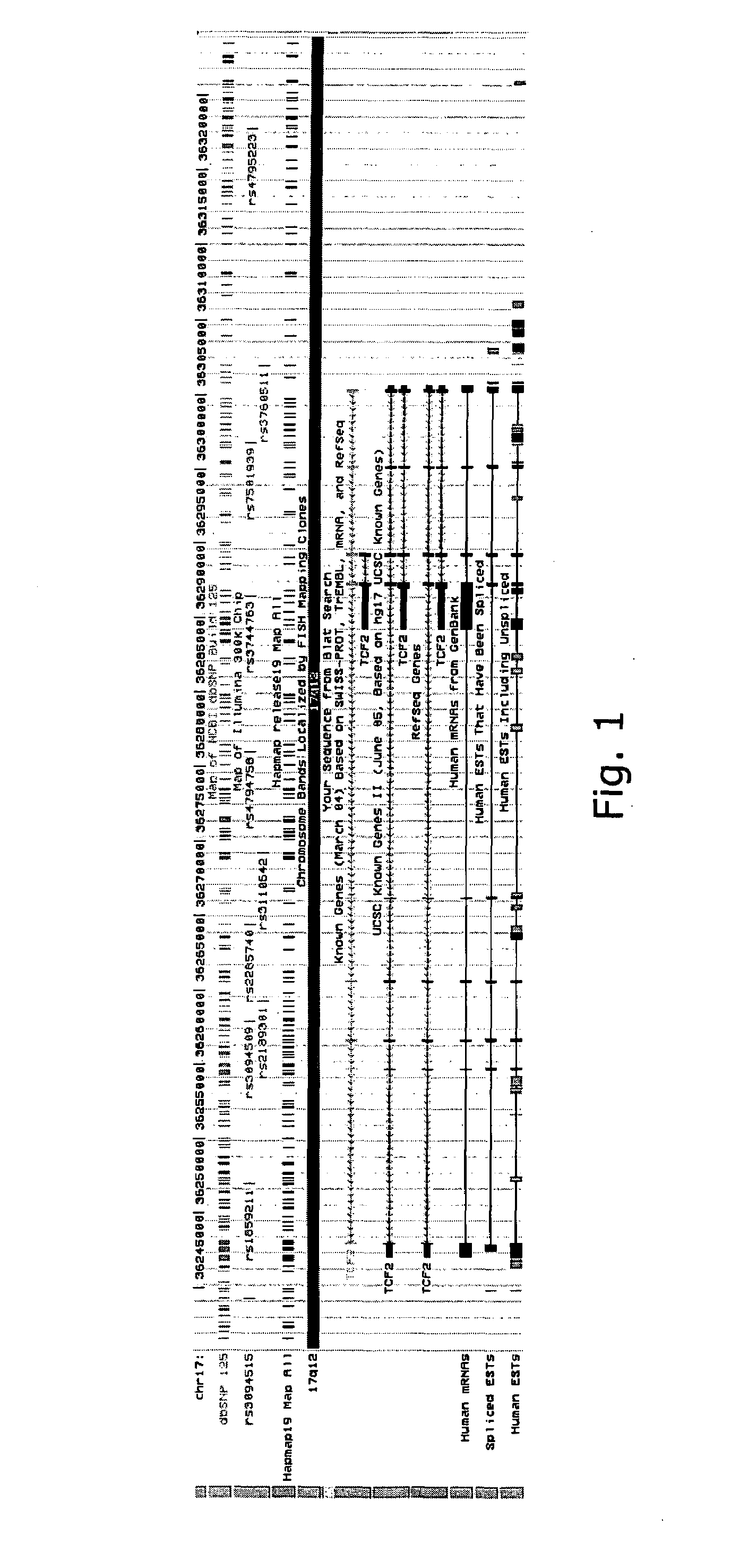Genetic variants contributing to risk of prostate cancer
a gene variant and prostate cancer technology, applied in biochemistry apparatus and processes, specific use bioreactors/fermenters, biomass after treatment, etc., can solve the problems of low cure rate, uncontrolled growth, and low cure rate of prostate cancer, and achieve the effect of increasing the susceptibility to prostate cancer
- Summary
- Abstract
- Description
- Claims
- Application Information
AI Technical Summary
Benefits of technology
Problems solved by technology
Method used
Image
Examples
example 1
Identification of Markers and LD Block Regions Associated with Prostate Cancer
Patients Involved in the Genetics Study
[0235]A population based list of all prostate cancer patients that were diagnosed with prostate cancer in Iceland from 1955 to 2005 form the basis for this study. Patients have been invited to join the study since 2001 on an ongoing basis. As of October 2006, blood samples from 1564 prostate cancer patients have been collected. Genomic DNA from 1455 of those samples, as well as samples from 7034 control individuals was extracted and genotyped.
[0236]A genome-wide scan of 1455 Icelandic individuals diagnosed with Prostate Cancer and 7034 population controls was performed using Infinium HumanHap300 SNP chips from Illumina for assaying approximately 317,000 single nucleotide polymorphisms (SNPs) on a single chip (Illumina, San Diego, Calif., USA). SNP genotyping for replication in other case-control cohorts was carried using the Centaurus platform (Nanogen).
Stat...
example 2
Two Sequence Variants Conferring Risk of Prostate Cancer Identified on Chromosome 17 and One of them, in TCF2, Shown to be Protective Against Type 2 Diabetes
[0246]Prostate cancer is the most common non-dermatological cancer of males worldwide, and the second leading cause of cancer-related death in men from western industrialized countries1. Firmly established risk factors for this type of malignancy are age, ethnicity and family history. In addition diet, lifestyle, and circulating androgens may have impact on the risk. Despite a large body of evidence for a genetic component to the risk of prostate cancer, the variants on 8q24 are the only common sequence variants reported so far that account for substantial proportion of the cases2-5.
[0247]In the present study we began with a genome-wide SNP association study to search for sequence variants conferring risks of prostate cancer using Icelandic cases and controls. We expanded the data from a study previously reported3, by increasing...
example 3
Further Evidence for Sequence Variants on 2p15 and Xp11.22 Conferring Susceptibility to Prostate Cancer
[0309]Further characterization of association of variants on Chr. 2p15 and Xp11.22 was performed, as shown in Tables 16 and 17. As before, allele A of the SNP rs5945572 (rs5945572 A) showed the most significant P value of markers located on the X chromosome in a GWA analysis of 23,205 Icelandic samples, with an allelic specific odds ratio (OR) of 1.21 (P=3.36×10−4) (Table 16). On chromosome 2p15, allele A of rs2710646 (rs2710646 A) had an OR of 1.16 (P=7.79×10−4) (Table 17) for all Icelandic prostate cancer cases and an OR of 1.33 (P=3.73×10−5) for patients diagnosed with aggressive disease (Table 18). By examining the Utah CEPH (CEU) HapMap data we identified numerous SNPs that are substantially correlated with either of the two anchor SNPs, rs5945572 and rs2710646 (D′≧0.9 and r2>0.4). From this list we selected several SNPs not present on the Illumina Hap300 chip, representing di...
PUM
| Property | Measurement | Unit |
|---|---|---|
| Frequency | aaaaa | aaaaa |
| Crystal polymorphism | aaaaa | aaaaa |
| Linkage disequilibrium | aaaaa | aaaaa |
Abstract
Description
Claims
Application Information
 Login to View More
Login to View More - R&D
- Intellectual Property
- Life Sciences
- Materials
- Tech Scout
- Unparalleled Data Quality
- Higher Quality Content
- 60% Fewer Hallucinations
Browse by: Latest US Patents, China's latest patents, Technical Efficacy Thesaurus, Application Domain, Technology Topic, Popular Technical Reports.
© 2025 PatSnap. All rights reserved.Legal|Privacy policy|Modern Slavery Act Transparency Statement|Sitemap|About US| Contact US: help@patsnap.com

